It has now become essential to learn how to use Zoom for the majority of people. This is due to the rise of work from home jobs and distance learning. Even if you don’t work from home, high chances are that you know what Zoom is.
Virtual meeting platforms like Zoom are now a standard in this day and age of communication. Regardless if you’re working from home or simply keeping in touch with family and friends, Zoom has now become a necessity.
What is Zoom?


Zoom is a cloud-based video conferencing platform that allows users to meet and work together face-to-face without the need of physically being in the same room. For many, it is considered as one of the best virtual meeting platforms. It’s a linchpin in today’s era of virtual meetings, with key features including video and audio conferencing, live chats, and screen-sharing.
Core Features:
- HD video and audio — This video conferencing app offers HD video and audio support for one-on-one meetings with the free plan. Users can host up to 100 participants on this plan, though this comes with a 40-minute limit per meeting.
- Screen-sharing and collaborative whiteboards — Participants can share their screens with others in the meeting. This feature is perfect for presentations and workshops. It also has a whiteboard feature that allows participants to annotate or draw on screen.
- Recording meetings — Zoom Meetings lets you record video conferences and save it either on your local device or on Zoom’s own cloud storage. By doing so, other participants can easily access and recap the Zoom recording again.
- Zoom Chat — The video conferencing app also offers an instant messaging feature, which is a step above the rest. This allows participants to message each other while in a video conference. Besides chats, people can also share files while in a virtual meeting.
Getting Started
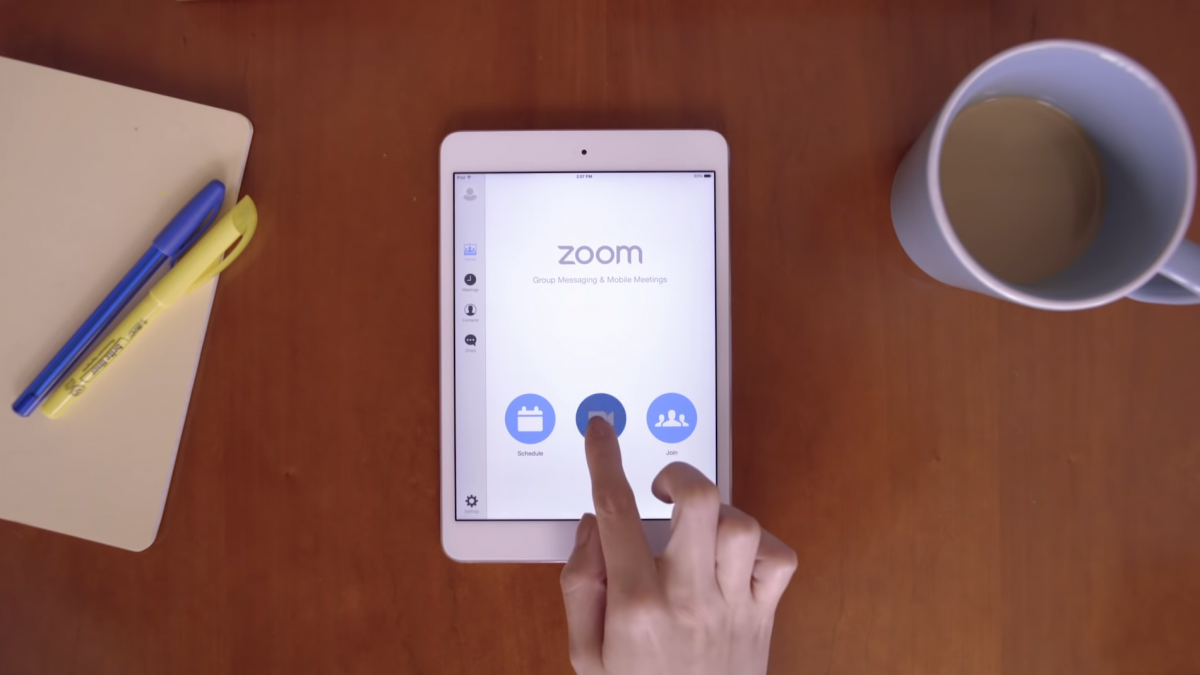

If you’re new to the whole work from home set up and are asking yourself how does Zoom work, well worry no more. We’ve got everything you need to know about this essential communication tool.
How to Use Zoom on Laptop
While you don’t necessarily need a Zoom account to join a meeting, you will need to download the Zoom app.
You can download Zoom for Windows or MacOS on the Zoom website. After installation, learning how to use Zoom is a breeze. Once you launch the application, you can choose between joining a meeting or signing in.


As mentioned above, it’s not a prerequisite to have an account in order to join Zoom conference calls. However, you will need to sign up for one if you want to schedule and host meetings yourself. Users have the option of signing in using either their Google or Facebook account. There is also the option of single sign-on (SSO), which allows you to log in using your company credentials.
After signing in, you will be directed to the Home tab wherein you can choose from these options:
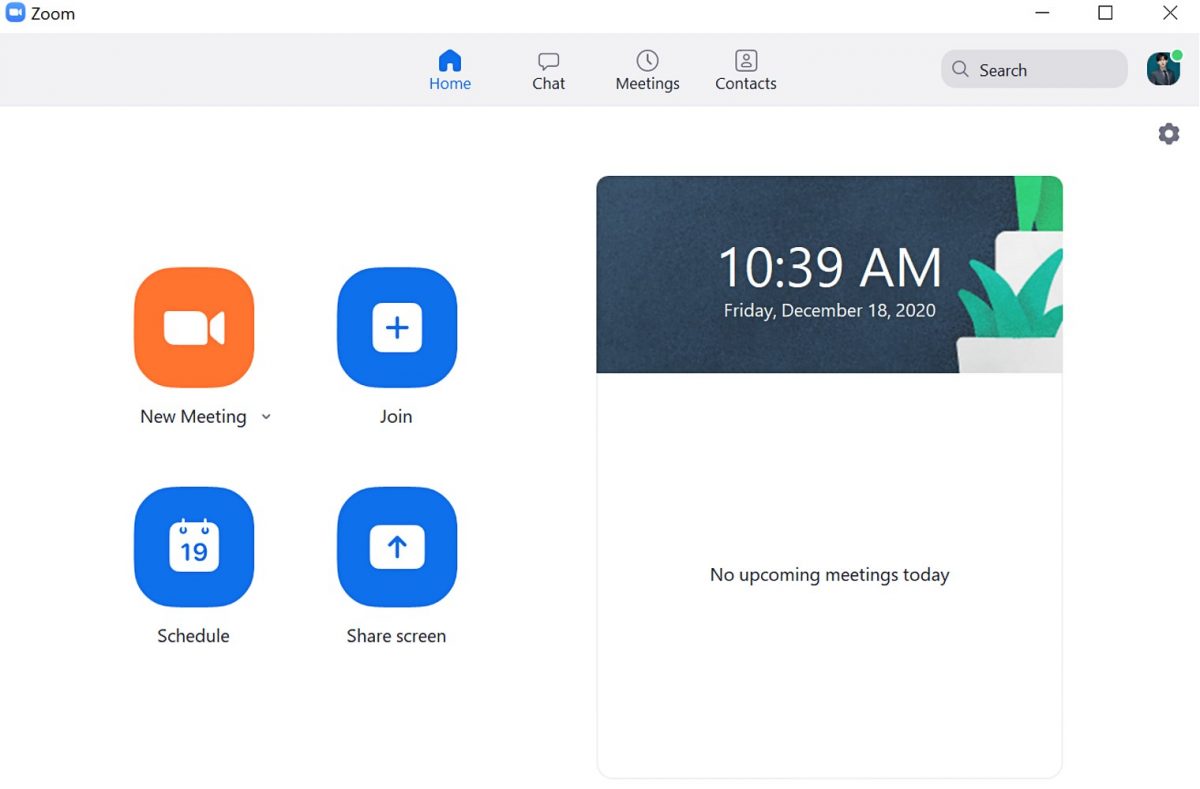

- New Meeting – By clicking this, you can host your own meetings. As the host, you are the one to provide details such as ‘Host Name,’ ‘Meeting Topic,’ and the ‘Room Password.’
- Join – This option lets you join a meeting that’s already in progress.
- Schedule – Choosing this option allows you to set up a future video conference call. You can select the date and time of when you want to schedule the video conference. Same as the ‘New Meeting‘ option, you will be the one to provide details such as topic and password.
- Share Screen – This option allows a participant to share their screen immediately once entering a meeting.
Users can also see their upcoming Zoom meetings at the Home tab.
If you look at the upper right corner of the application, you will see your profile photo. Once you click on the icon, you can access more options. Here you can access “Settings” and “My Profile,” which directs you to Zoom’s website wherein you can edit and update your personal information. Moreover, you can also select your “Status,” which lets other people know if you’re available for an impromptu call or not.
Additionally, you can also check for a Zoom update, the Zoom Help Center button, and the sign out option.
How to Set Up a Zoom Meeting
If your query is on how to set up a meeting on this application, here’s a simple guide to show you how.
As stated above, there are two options on starting a meeting. You can either choose from starting a meeting right away, or schedule it for a later time and date.
Once you click on ‘New Meeting,’ the application will launch a new window. If this is your first time using Zoom, it will ask permission to access both your device camera and microphone. A dialogue box will appear; here you’ll have the options to ‘Join with computer audio,’ or ‘Test speaker and microphone.’ Users can check to see if both their microphone and speakers work properly before starting a video conference.
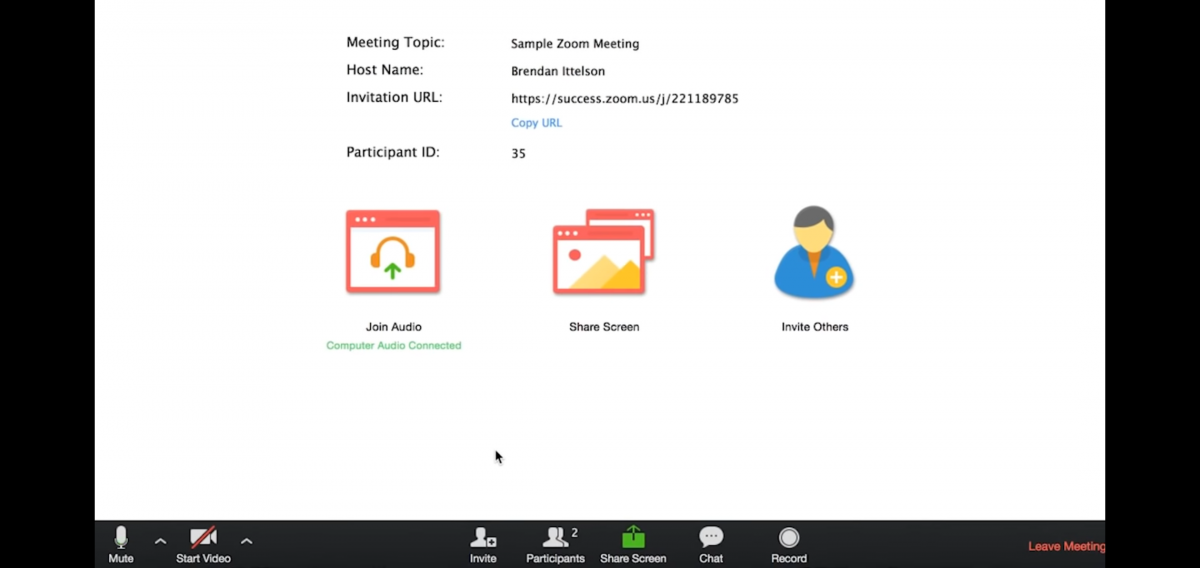

Once you’ve done so, you can go ahead and click on ‘Manage Participants‘ below. There you will see the option to invite other people into the meeting room.
You can choose from three options: send the invite to a person already in your Contacts list, send it via email, or copy the invite link and directly message the other participants yourself.


If you plan to set up a meeting at a later date, you will need to click on the Schedule icon. A dialogue box will pop up and you must fill up all details such as topic title, time and date, duration of the conference, and Time Zone.
As host, you will also have the option to allow participants to use their video and microphones during the meeting. Other meeting options include requiring a password before joining the meeting and allowing the participants to enter the meeting room even without the host.
Once everything is set up, click on the Save button below and your invite will be sent to the participants.


How to Join a Zoom Meeting


There are three options on how to join a meeting.
Join Via Email
If you’ve received an invite via email, you can simply click on the link provided. Once you do so, a new tab on your browser window will open. Here you’ll be prompted to either download the app (if you haven’t already) or launch the application.
If the host has not started the meeting, you’ll see this dialogue box:
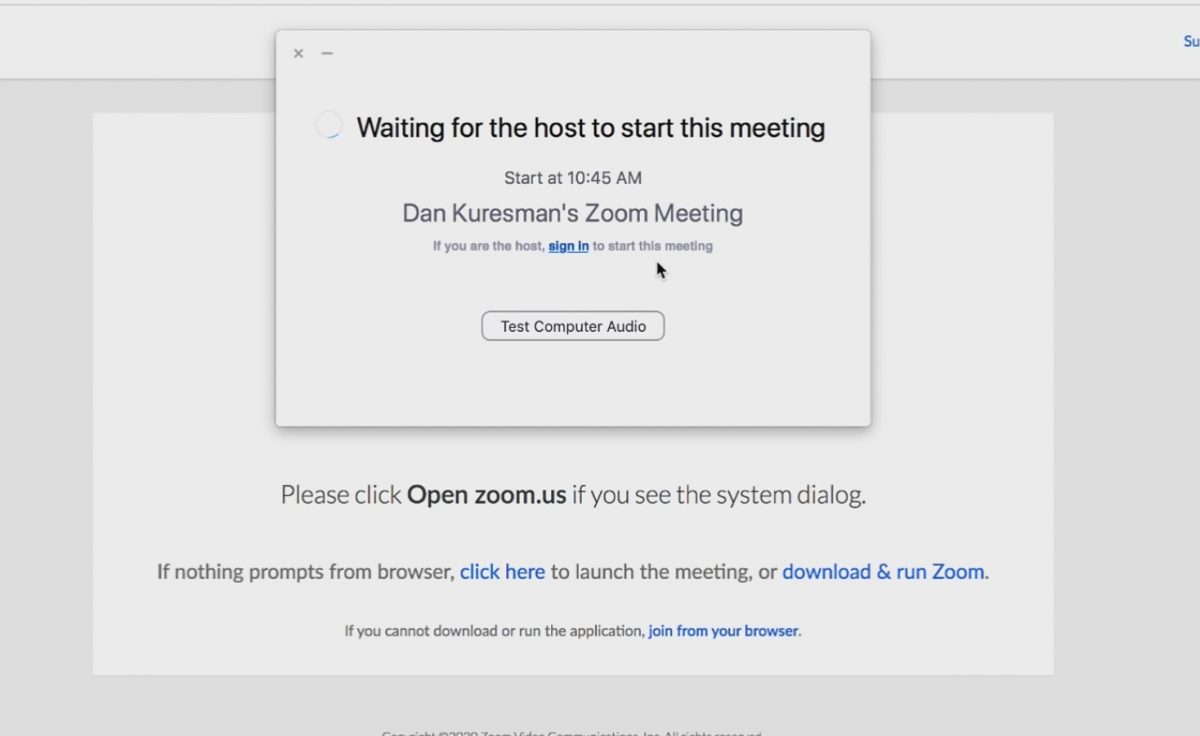

You will need to wait until the hosts properly start the video conference or webinar to enter the meeting room. While waiting, you can check your laptop’s audio quality and test your microphone. Moreover, while you wait for the host to start the conference on their end, you can also check your video quality. On top of that, you can also select a Zoom background photo and filter you want to use during the virtual meeting.
Join via Meeting ID
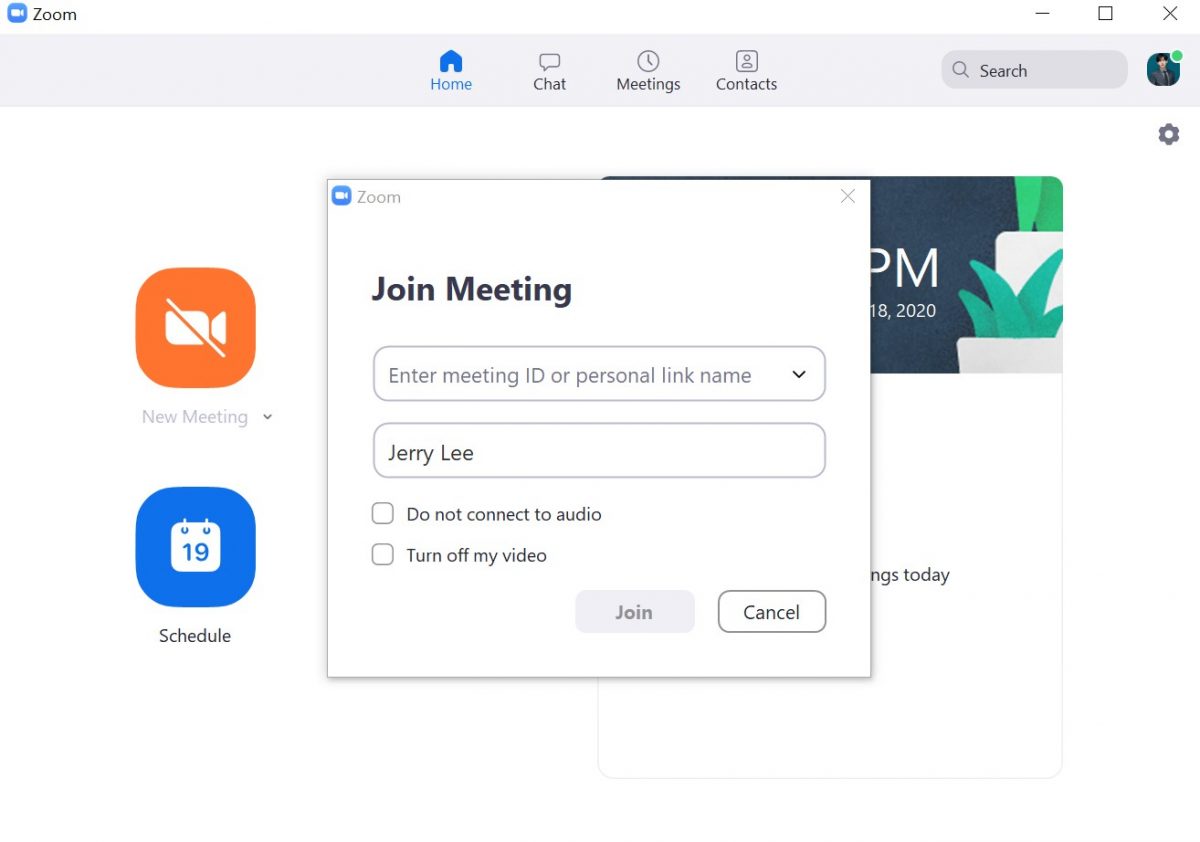

Another way to join conference calls is to click on the ‘Join‘ button found at the Home tab of the app. This will launch a new application window. There, you can manually enter the Zoom Meeting ID provided by the host, as well as your display name. Additionally, you’ll have the option to decide if you want to join the video conference with your camera on. You can also select if you want to connect your audio and microphone.
Join via Meetings Tab
The third option of joining a Zoom meeting is via the Meetings tab found on the app. You can click on it to view all your upcoming meeting invites. Select the meeting you’re going to join, and simply click on the ‘Join‘ button.
How to Share Screen on Zoom
Learning how to share your screen on Zoom is a simple way for others to see what you see on your own computer. Be it for a presentation for work or just want to watch a video with friends, Screen Sharing is a useful tool.
There are two ways on how to share screen on Zoom. If you’ve yet to join the Zoom video conference, you can click on the ‘Share Screen’ button found on the Home tab of the application. Afterwards, enter the credentials required and click ‘Join‘. Once you’ve entered the Zoom room, you’ll see a pop-up window with options on what to share on screen.
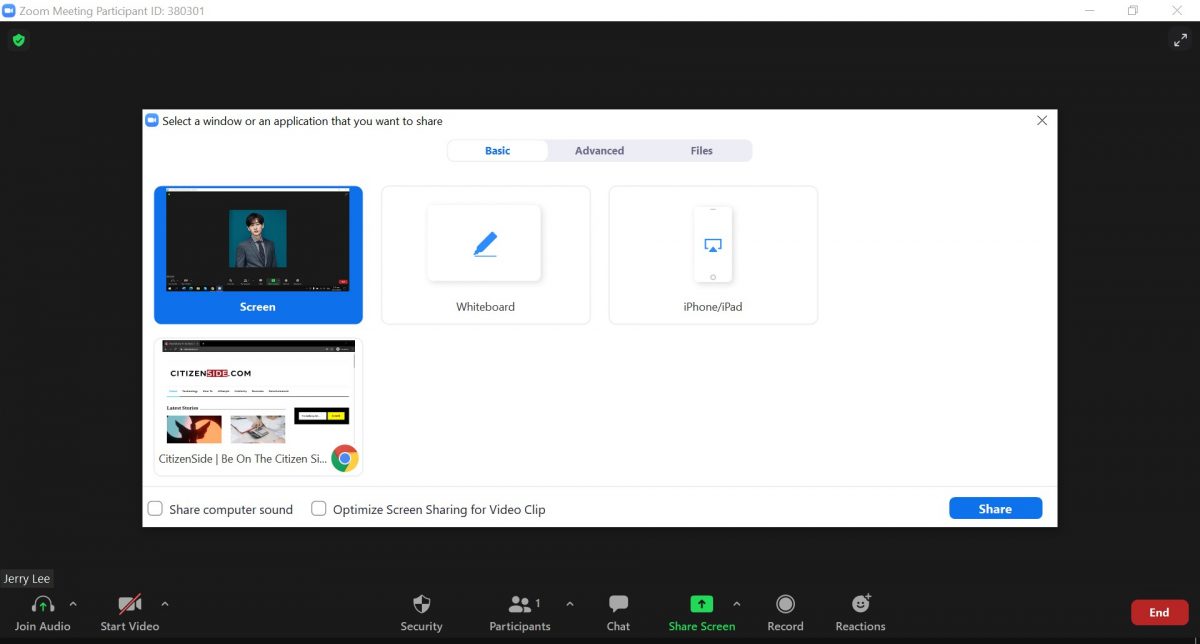

From here you can select what you want to share with the other participants in the call.
You can select to share your whole window, a specific application, or even a whiteboard for annotation. Additionally, the Zoom Screen Sharing feature also has more advanced options. These features include using a PowerPoint presentation as your background, and selecting only a specific part of your screen to share. Furthermore, you also have the option of only sharing the audio or music you play on your device.
Once you have selected what screen or document you want to share with other participants, click on ‘Share,’ and other people will be able to see your screen. However, if you’re already on a video call, simply click on the ‘Share Screen’ button found on the toolbar at the lower part of the screen. This will launch the same pop-up window as mentioned above. You can simply follow the steps mentioned to share screen on Zoom.
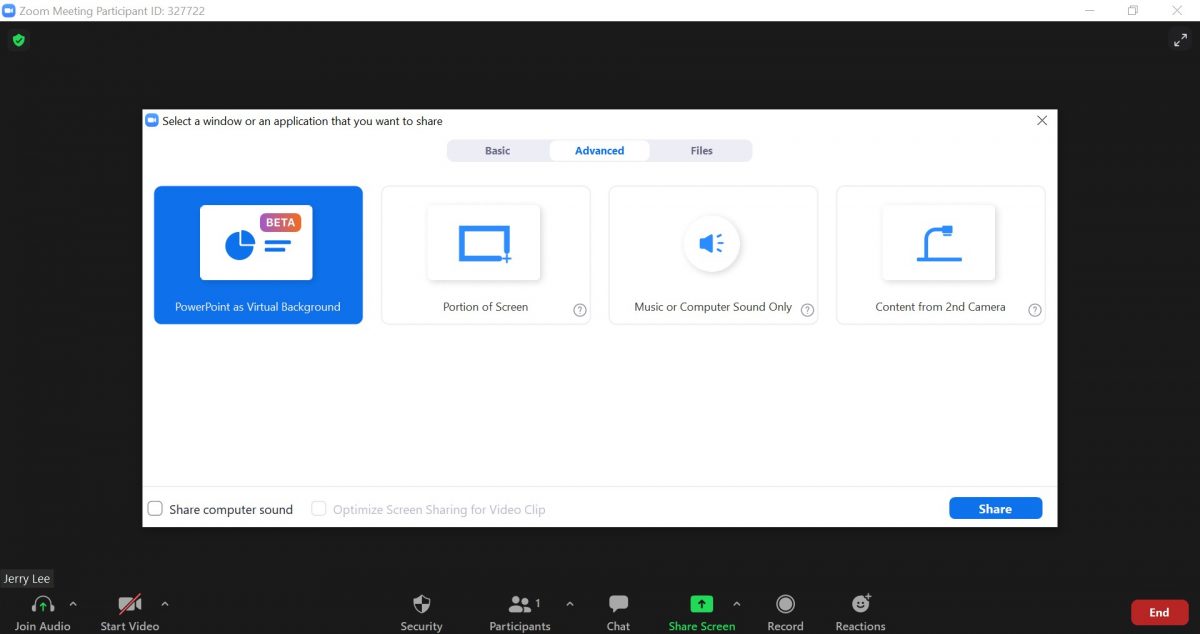

Tips and Tricks for Zoom


How To Change Background On Zoom
As mentioned above, you can change your background on this immensely popular video conference app. By doing so, you can add some flair and fun to your video meetings. Moreover, if you tend to have a cluttered setup at home, adding a background photo comes in handy in order to maintain a professional image during work meetings.
If you’re using the Zoom desktop client, here’s how to change your Zoom background.
- On the app, click your profile photo at the top right corner, then select ‘Settings.’
- A pop-up window will appear. Select ‘Backgrounds and Filter’ on the menu bar on the left side.
- On the ‘Virtual Backgrounds’ tab you will see the default background images that Zoom’s provided. You also have the option of selecting a background from your gallery.
- You will also see the ‘Video Filters’ tab for when you want to add some bright and fun filters to your video.
- Select the one you want to use and close the window.
You can also change your Zoom background on Android and iOS devices.
- Join or start a meeting.
- Select ‘More’ on the bottom right corner of your screen if you’re using an iPhone. This option is found on the upper right corner if you’re an iPad user.
- Choose the ‘Virtual Background’ option.
- You can select from the preset photos provided by the program or tap on the + icon to use your own image.
- Select an image you want and you’re good to go.
It is important to take note that you might have to check your system requirements to successfully change your background.
How To Raise Hand In Zoom


The raise hand Zoom feature allows participants of webinars and virtual meetings to signal that they have a question or comment. This is perfect for getting the speaker or moderator’s attention without verbally disturbing the person talking.
Here’s how to raise your hand if you’re using the app on your desktop computer or laptop.
- Once you’ve joined a meeting as a participant, click the ‘Participants‘ button found at the bottom of the screen.
- The participants list will pop up. At the bottom right corner you will see a ‘Raise hand‘ option.
- Once you click on it, the app will notify the host that you wish to speak or ask a question.
If you wish to lower your hand, follow the steps above. But, instead of the ‘Raise hand‘ option, you will see the ‘Lower hand‘ button instead.


For Zoom mobile users, you can easily find the ‘Raise hand‘ icon at the middle of the screen. Simply click on it and it will notify the host or speaker that you’ve raised your hand.


How to Record Zoom Meetings
Zoom’s recording feature is a wonderful work from home tool. It’s perfect for those working professionals that need to reflect on topics discussed during meetings. It’s also a prominent feature for teachers that want to provide review materials for their students amidst distance learning.
However, if you’re only a participant, you will need permission from the host of the meeting to record the video conference.
Here’s how to record a Zoom meeting on desktop devices.
- Once you’ve set up the Zoom meeting, click on the ‘Record’ button found on the lower part of the screen.
- You’ll be prompted on where you want to store the recording; choose between ‘Record on this Computer’ to save the video recording on your local storage. You can also choose ‘Record to the Cloud’ to save it on Zoom’s own cloud-based storage.
- The recording will begin now. You will now see a ‘Pause/Stop Recording’ button in lieu of the ‘Record’ button. From here you can decide if you want to pause or entirely stop recording the Zoom call.
For those on mobile devices, recording a Zoom meeting follows similar steps.
For Android devices, tap on the ‘Record’ button to initiate the recording of the Zoom meeting. Tap on the ‘More’ button once again if you wish to pause or stop the recording.
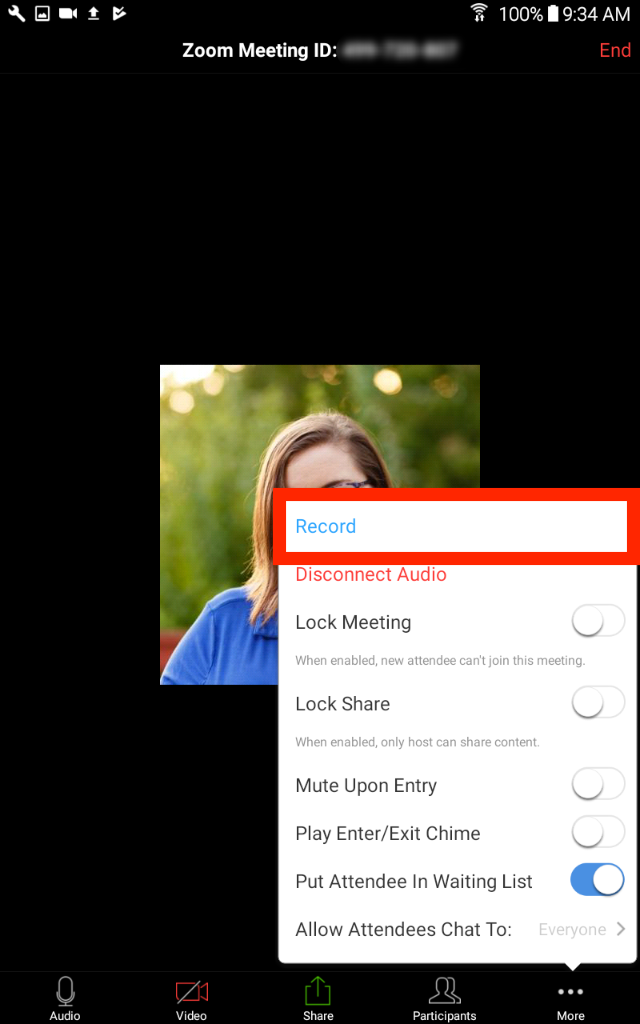

Comparatively, for iOS devices, the steps are similar to that of Android devices. However, once you tap on the ‘More’ button, instead of ‘Record,’ you will see ‘Record to Cloud.’ This means that your recording will automatically save to the Cloud instead of your device’s local storage.


How To Update Zoom
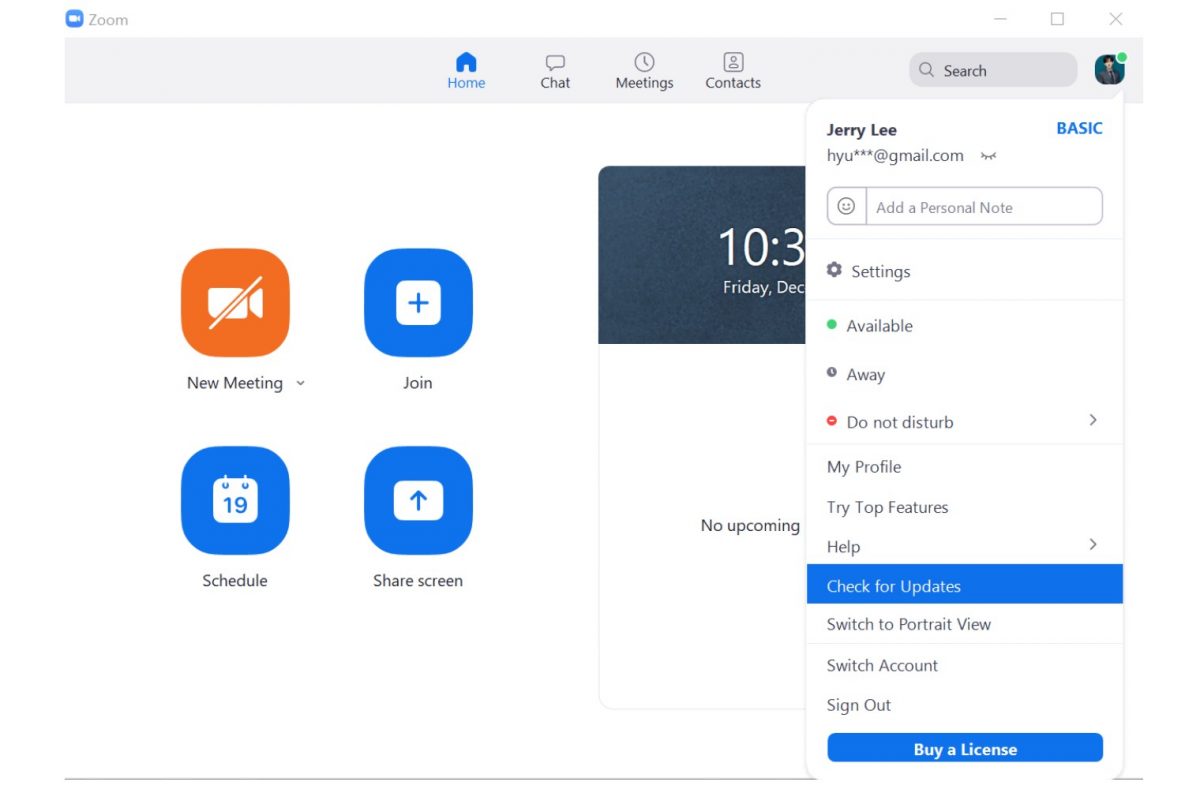

If you’ve been using the program for a while, you may want to consider upgrading to the latest version if you haven’t already. Updating to the latest version once it is available means that you get all the new features of the app. Additionally, Zoom also fixes bugs and glitches when they roll in a new update.
For users of the Zoom desktop client, here’s how to get the latest update and version of Zoom.
If there is a new version or update of Zoom, the application provides a pop-up notification or reminder. Although, you can still check for the latest version of the program manually.
- Click on the icon in the top right on the home screen.
- Select ‘Check for Updates.’
- The application will check if there are any new updates or the latest available version. If there is one available, Zoom will automatically begin the download and installation of it. Take note that while Zoom is updating, you cannot make or join any Zoom calls. However, if you have the latest version installed, a dialogue box will appear saying that your version is up to date.
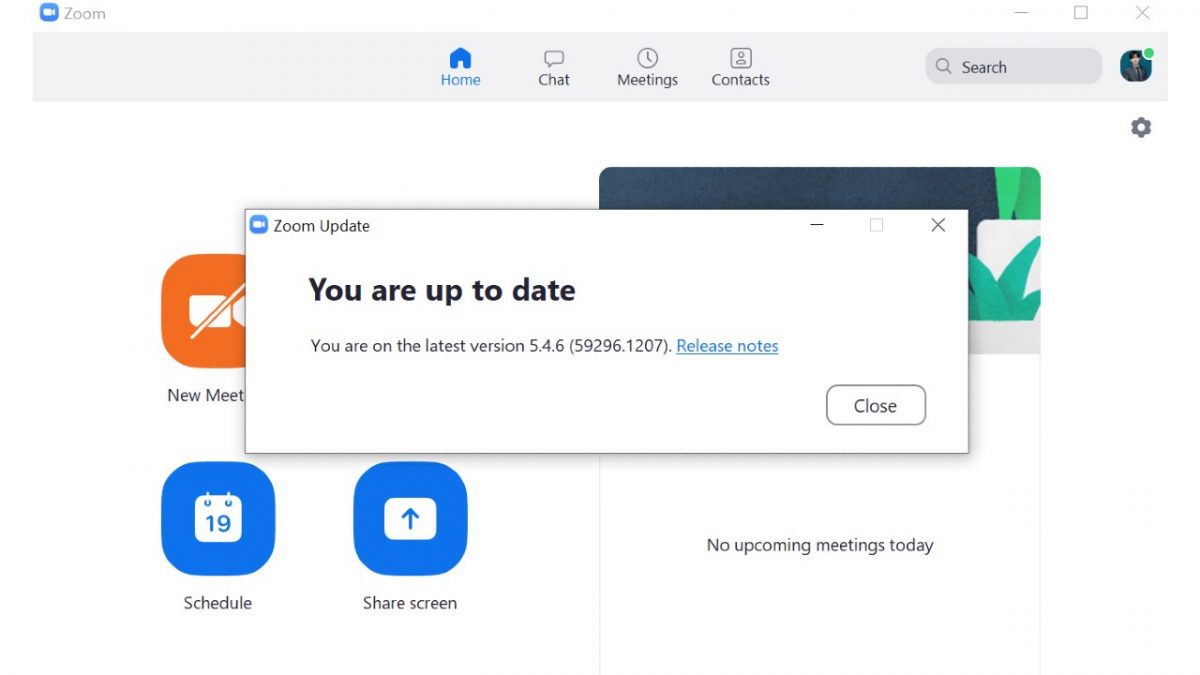

Additionally, another way to download the latest version of the app automatically is to go to the Zoom Download Center.
Meanwhile, for Zoom mobile users, updating the app is fairly simple. You can go to the App Store for iOS devices, or the Google Play Store for Android devices, to see if your Zoom app needs any updates. Furthermore, you will also see a pop-up notification on your mobile screen if your app is in due for an update.
Zoom Plans – Are They Worth It?


Zoom’s free plan already offers an abundance of features that are perfect for personal use. Even for a small group who only need a quick virtual meeting, the free Zoom version is already sufficient. However, for businesses that need to host virtual meetings with over 100 participants, the Zoom free version may not be the best option. Moreover, another limitation of Zoom’s free version is that meetings can only run for as long as 40 minutes.
With that in mind, Zoom Meetings offers four additional paid plans. Pricing is fairly affordable with the starting price at $14.99 per month or $149.90 per year. Take note that billing is on a per-host basis. This means that only the host account will need to purchase a license or subscription. If you’re a participant and webinar attendee, you needn’t purchase a license.
Moreover, paid Zoom plans offer secure access to Zoom’s application programming interface (API). Zoom API allows developers to request resources and data from Zoom. This includes Zoom dashboard data, user details, meeting reports, etc. On top of that, a paid Zoom subscriber also has the privilege of performing actions on Zoom on a user’s behalf. This includes creating a new user or deleting recordings of meetings.
Zoom Pro
Geared towards small teams, the Zoom Pro plan offers everything that the free Zoom version has. However, your meetings can last up to 30 hours, although this plan still only limits the meetings to 100 participants. Additionally, you also receive one gigabyte worth of Zoom’s cloud-based storage to save your Zoom recordings.
The Zoom Pro plan allows a user to assign someone else to set up a Zoom meeting for you. However, take note that the assigned scheduler must also have a Pro Zoom plan. Another benefit of this plan is that you can livestream your Zoom meetings on platforms such as Facebook, YouTube, or other third-party websites. Moreover, with this plan, users have more administration controls. As such, this allows them to add, remove, or assign roles to participants of the Zoom call.
The Zoom Pro plan costs $14.99 per month or $149.90 per year.
Zoom Business
Designed for small and medium-sized businesses, the Zoom Business plan offers all features of the Pro and Basic plan, as well as a few additional benefits.
With this plan, the participant capacity is raised to 300 members in a meeting. It also allows hosts to customize meeting URLs and business domains to better integrate company branding. Moreover, hosts of this plan can also manage users in their company on a single account. This means simplified billing and more advanced user management settings. Additionally, this plan also provides users with comprehensive usage insights.
Furthermore, the Business plan also offers cloud recording transcripts of a meeting or webinar that has been recorded onto the cloud. However, it’s important to take note that this feature currently only supports the English language.
Zoom’s Business plan starts at $19.99 per month or $199.90 per year.
Zoom Enterprise
Tailored for bigger companies, Zoom Enterprise is the perfect plan if you need to host a meeting or webinar with 500 participants. The major difference between Zoom’s Enterprise and Business plan is the amount of participants allowed in a meeting. However, users of this plan also get unlimited cloud storage for recording meetings.
Additionally, this plan offers executive business reviews, which includes Return on Investment (ROI) tracking, detailed adoption trend analyzes. Users of this plan also get product roadmap discussion privileges. Another perk Zoom’s Enterprise plan offers is the bundled discounts on webinars. Moreover, Zoom Enterprise provides a dedicated customer support manager for this plan’s subscribers.
Same as the Business plan, Zoom’s Enterprise plan is priced at $19.99 per month and $199.90 per year.
Zoom United Business
The program also offers a United Business plan that merges its video and audio conferencing feature with their instant messaging and cloud based phone system. This plan perfectly targets those with businesses who would need more than just the basics of the Zoom Phone plan.
With Zoom’s United Business plan, users get all the phone features of Zoom’s United Pro plan, alongside the benefits of the Zoom Business plan. A user can host a meeting with up to 300 participants, record transcripts, and customize business domains. Additionally, a business can better integrate company branding with this paid plan. Moreover, Zoom’s United Business plan offers unlimited calls, although this is only limited within US and Canadian territories.
Priced at $30 per month and at $300 per year, this Zoom plan is great for individuals who want more from the Zoom Business and Enterprise plans.
Zoom Security


Thanks to the boom of work from home jobs, the popularity of the program has undeniably soared. However, with this in mind, cybersecurity threats have come to light amid this. The question on many people’s mind now: is Zoom safe to use?
The chief concern for many is when others somehow obtain access to Zoom calls without an invitation link. Labeled Zoombombing, this act is mostly an attempt to wreak havoc at the expense of the participants. This usually harmless act is slowly growing to be a major concern in terms of cyber attacks.
Aptly labeled as Zoombombers, the uninvited people show up during ongoing Zoom sessions. Once a Zoombomber hijacks an ongoing Zoom session, they often disrupt the video conference by saying or showing lewd, obscene, and even racist things. This results in the host having to end the compromised meeting.
Due to the growing concern on Zoombombing, the company has released several security updates to prevent the act. The company has released 100 additional security features to further improve its services. These new features include an enhanced Two-Factor Authentication (2FA) method that makes it easier for hosts and moderators to protect participants and prevent security breaches. Additionally, Zoom also implemented end-to-end encryption for all users.
Why Zoom?
There’s no denying the plethora of Zoom advantages and disadvantages. For many of the app’s users, its key selling point is its ease of use. This video conference app provides a straightforward solution to remote collaborations. One just needs to install and set it up, then they’re good to go. Even the less tech-savvy can easily maneuver around Zoom’s interface in a breeze. Additionally, one doesn’t even need an account to use it, which makes it perfect for casual participants of webinars.
Cost wise, the Zoom free version – while it has some notable limitations – already offers everything you need in a great video conference tool. The paid counterpart of the app also offers different tiers to suit you and your company’s needs. Additionally, these paid tiers are all reasonably priced. Thus, improving a business’ productivity and efficiency wouldn’t need to come at a high cost.
Overall, the reason so many people across the globe have turned to Zoom is because it’s easy to use and free. However, more and more competitors are stepping up their game to catch up to the widely popular app’s trail blaze.
Zoom Alternatives
Google Meet
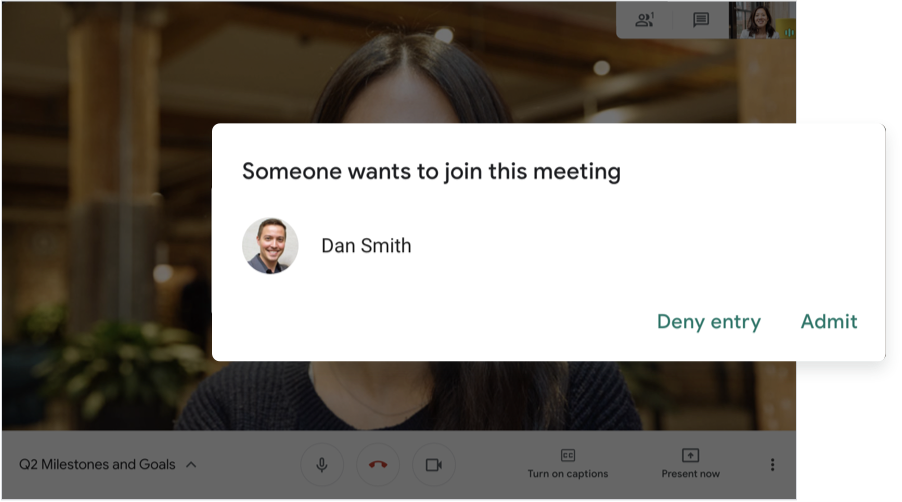

Google’s own video conferencing platform shares similar features with Zoom. However, what sets it significantly apart from Zoom is its highlight on user security. Google Meet boasts its focus on security with its built-in protection.
As mentioned above, Zoom has taken steps to up their game in terms of cyber security. However, it’s safe to say that Google Meet has been long in the forefront of protecting their users’ privacy from the get-go. Users can rest assured that security of their video meetings and other data are encrypted by default.
In terms of video conferencing, Google Meet allows 100 participants and a 60-minute limit per meeting for its free version. Additionally, since it’s integrated with Gmail, a user can join a video call on Google Meet right from their web browser. Thus, a user doesn’t need to install another application or add-on to use Google Meet so long as they have a Gmail account.
The downside of Google Meet, though, is that to access additional Zoom-like features such as recording meetings, live streaming the meeting, and administrative controls, you will need to upgrade to a paid plan.
Google Meet’s paid plan starts at $8 per month.
Microsoft Teams


Another go-to Zoom alternative for many, Microsoft Teams combines video meetings, instant messaging, calls, and file sharing with Microsoft’s Office 365. Additionally, Microsoft Teams also offers unlimited app integrations. This includes – but is not limited to – apps like Adobe and Evernote.
However, it seems like Microsoft Teams is geared towards smaller teams. While a video call can host up to 250 members, you can only see 20 participants on a call simultaneously. Another downside is when it comes to file sharing, the Microsoft Teams free version only allows 10 attachments per session. Furthermore, another downside of Microsoft Team is its user interface (UI).
While Zoom offers a simplified UI, that cannot be said for Microsoft Teams. New users may find difficulty in maneuvering and setting up this video conferencing tool.
Microsoft Teams offers both a free and paid plan, with the paid plan starting at $5 per month.
Skype
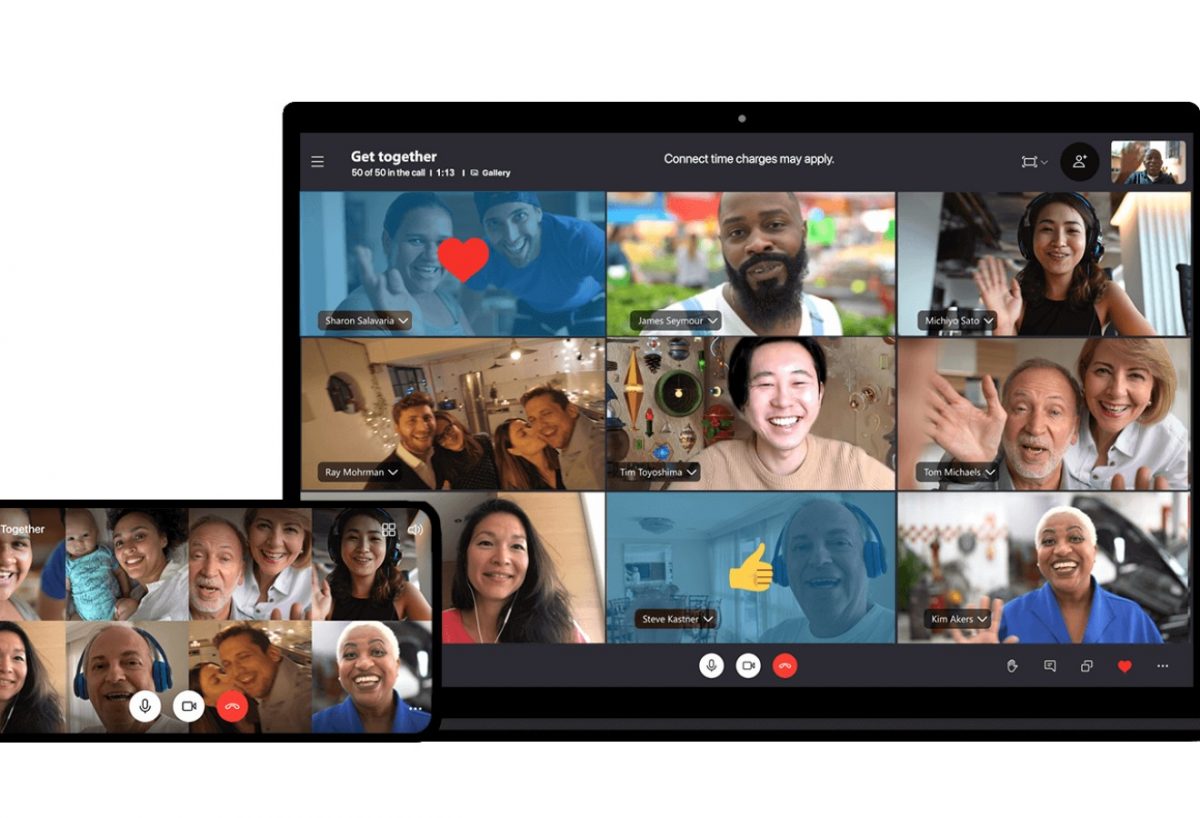

One of the most popular video communication applications, Skype is definitely a worthy rival to that of Zoom.
Skype has recently introduced Zoom-like features; this includes a raise hand feature, screen-sharing, and video call recording. Additionally, Skype has also incorporated a live captions and subtitles feature for video calls. Besides this, this video communication tool also offers real-time translation of Skype video and audio calls.
With Skype, 100 people can join a single video conference from just about any device. Skype is available on mobile, tablet, computer desktop, and even on the Xbox. Other Skype features include background effects and blurring, location sharing, and up to 300 MB of file sharing.
Overall, Skype is undoubtedly an honest challenger for Zoom, especially because all of these features are free.
Discord


Another Zoom alternative that’s used for remote work and distance learning is Discord. Originally tied to the gaming community, Discord has now turned to one of the best Zoom alternatives used by teachers and students.
While it offers video and audio calls, Discord’s principal means of communication is textual. However, that does not mean Discord isn’t putting more effort into their video-calling features. With their recent updates, it is rather obvious that they are stepping up their game to stay at par with other video communication tools.
Discord also offers encrypted chats, with chats taking place within rooms on dedicated servers. It is usually the user that sets up these servers. Moreover, similar to Zoom, it also features a share screen feature. However, unlike Zoom, users can connect it to Spotify to listen to music together.
Furthermore, a downside to Discord is like that of Microsoft Teams — the UI. While Discord’s black background and cartoon-ish design may look playful, its interface is not the most user-friendly. Many find it straight up difficult to operate, and it may take some time to start a server successfully.
Moreover, since it is geared towards the gaming community, you may be tempted to watch your favorite streamer play the best free Steam games instead of actually paying attention to your own work meetings.
The Bottom Line
Overall, Zoom Meetings provides top-notch performance while being undeniably easy to use. Regardless if you’re using the Zoom free version or have upgraded to a paid plan, learning how to use Zoom is quintessential nowadays.
Although, one cannot deny how Zoom’s security weaknesses hinders it from being the best audio-video communication tool there is. Nevertheless, with its recent commitment in providing better privacy and security features, it won’t come as a surprise if Zoom ever does claim the title.
However, with other competitors increasingly stepping up their game, it is possible for the likes of Google Meet or Discord to snatch the moniker sooner or later.

